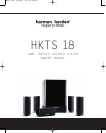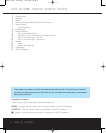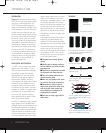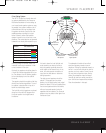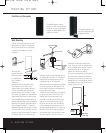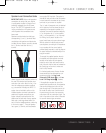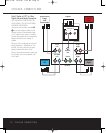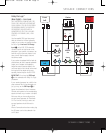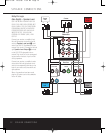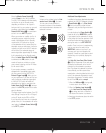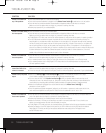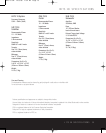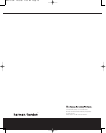
6 SUB-TS18 SUBWOOFER AMPLIFIER PANEL CONTROLS AND CONNECTIONS
SUB-TS18 SUBWOOFER AMPLIFIER PANEL CONTROLS AND CONNECTIONS
p
lace itself in the Standby mode, depending on
whether it is receiving an audio signal. When
this switch is placed in the
ON position, the
SUB-TS18 will remain on, whether or not it is
receiving an audio signal.
An LED located on top of the SUB-TS18
indicates whether the SUB-TS18 is in the On
or Standby state when used with the
Audio-
Sense On/Off Switch
¢ in the AUTO
position. The LED is lit blue to indicate that
the SUB-TS18 is receiving an audio signal
and is turned on, and the LED is lit amber to
indicate that no signal is being received and
the SUB-TS18 is in the Standby mode.
When the
Audio-Sense On/Off Switch ¢
is in the ON position, the LED will be lit
blue, whether or not an audio signal is
present.
When the
Master Power Switch ‚ is
turned off, the LED goes dark, no matter
which position the
Audio-Sense On/Off
Switch
¢ is in.
∞ Phase Switch: This switch determines
whether the SUB-TS18 subwoofer’s piston-
like action moves in and out in phase with
the main speakers. If the speakers were to
play out of phase, the sound waves pro-
duced by the subwoofer would be canceled
out, reducing bass response. This phenome-
non depends in part on the relative place-
ment of the speakers in the room. In most
cases, the
Phase Switch ∞ should be left
in the
NORMAL position. However, it
does no harm to experiment with the
Phase
Switch
∞, and you may leave it in the
position that maximizes bass response.
§ L
ine-Level Subwoofer (SUB) Input:
Connect the subwoofer output of a receiver
with digital surround sound decoding, such
as Dolby
®
Digital or DTS
®
, to this input. This
input bypasses the SUB-TS18’s internal
crossover circuitry, and should only be used
with a filtered signal. If your receiver does not
have digital decoding, you should use the
Line-Level Full-Range Inputs ¶ instead.
¶ Line-Level Full-Range Inputs: Connect
the line-level subwoofer output or preamp out-
put(s) of your receiver or amplifier to these
inputs. If your receiver does not have a sepa-
rate subwoofer output, use a Y-adapter (not
supplied) to bridge the receiver’s preamp out-
put to the main amp input for that channel,
and connect the long end of the adapter
to the corresponding line-level input on the
SUB-TS18. If your receiver has only a single
subwoofer output, you may connect it to
either the left or right line-level input on the
SUB-TS 18, and no Y-adapter is needed.
• Speaker-Level Outputs: If you are
using the
Speaker-Level Inputs ª on the
SUB-TS18, you should connect these binding-
post terminals to your front left and right
speakers, remembering to maintain polarity
by connecting the (+) terminal on the
SUB-TS18 subwoofer to the (+) terminal
on the speaker, and the (–) terminal on the
SUB-TS18 subwoofer to the (–) terminal
on the speaker. If you are not using the
Speaker-Level Inputs ª, then connect
your front left and right speakers directly
to your receiver or amplifier. See pages 9
through 12 for further infor
mation on speaker
connections.
ª S
peaker-Level Inputs:
I
f your receiver
or amplifier does not have a line-level sub-
woofer output, connect these binding-post
terminals to the main left and right speaker
terminals of your receiver or amplifier.
Remember to maintain polarity by connecting
the (+) terminal on the receiver/amplifier to the
(+) terminal on the SUB-TS18 subwoofer, and
the (–) terminal on the receiver/amplifier to the
(–) terminal on the SUB-TS18 subwoofer.
‚ Master Power Switch: Place this
switch in the “•” position to power-on the
SUB-TS18 subwoofer. The SUB-TS18 will
then be either in the Standby mode or com-
pletely on, depending on the position of the
Audio-Sense On/Off Switch ¢.
⁄ AC Power Cord: Make sure to plug this
cord into an active, unswitched electrical out-
let for proper operation of the SUB-TS18.
The cord should not be plugged into the
accessory outlets found on some audio
components.
HKTS 18 OM 10/6/06 1:34 PM Page 6



